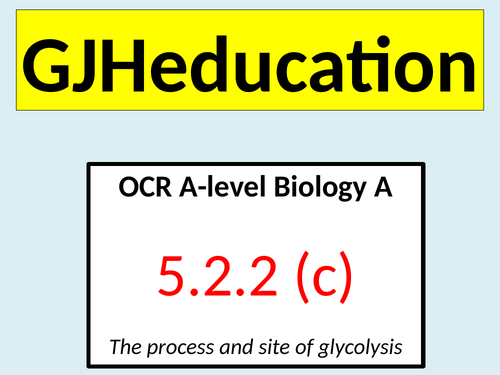



This fully-resourced lesson looks at the process and site of glycolysis and explains how the phosphorylation of glucose and the production and oxidation of triose phosphate results in 2 molecules of pyruvate. The engaging PowerPoint and accompanying differentiated resources have been designed to cover point 5.2.2 © of the OCR A-level Biology A specification.
The lesson begins with the introduction of the name of the stage and then explains how the phosphorylation, splitting and oxidation are the three main stages that need to be known for this specification. Time is taken to explain the key details of each of these stages and key points such as the use of ATP in phosphorylation are explained so that students can understand how this affects the net yield. A quick quiz competition is used to introduce NAD and the students will learn that the reduction of this coenzyme, which is followed by the transport of the protons and electrons to the cristae for the electron transport chain, is critical for the overall production of ATP. Understanding checks, in a range of forms, are included throughout the lesson so that students can assess their progress and any misconceptions are immediately addressed.
This lesson has been written to tie in with the other uploaded lessons on the Link reaction, Krebs cycle, oxidative phosphorylation and anaerobic respiration
Get this resource as part of a bundle and save up to 33%
A bundle is a package of resources grouped together to teach a particular topic, or a series of lessons, in one place.
Module 5.2: Photosynthesis & Respiration (OCR A-level Biology A)
Photosynthesis and respiration are two of the most commonly-assessed topics in the terminal A-level exams but are often poorly understood by students. These 14 lessons have been intricately planned to contain a wide range of activities that will engage and motivate the students whilst covering the key detail to try to deepen their understanding and includes exam-style questions so they are prepared for these assessments. The following specification points in modules 5.2.1 and 5.2.2 of the OCR A-level Biology A course are covered by these lessons: * The structure of a chloroplast and the sites of the two main stages of photosynthesis * The light-dependent stage of photosynthesis * The fixation of carbon dioxide and the light-independent stage of photosynthesis * The uses of triose phosphate * Factors affecting photosynthesis * The need for cellular respiration * The structure of the mitochondrion * The process and site of glycolysis * The link reaction and its site in the cell * The process and site of the Krebs cycle * The importance of coenzymes in cellular respiration * The process and site of oxidative phosphorylation * The chemiosmostic theory * The process of anaerobic respiration in eukaryotes * The relative energy values of carbohydrates, lipids and proteins as respiratory substrates * The use of the respiratory quotient Due to the detail of these lessons, it is estimated that it will take in excess of 2 months of A-level lessons to cover this module If you would like to sample the quality of the lessons, download the uses of triose phosphate, link reaction and respiratory substrates lessons as these have been shared for free
Module 5.2.2: Respiration (OCR A-level Biology A)
All 9 of the lessons included in this bundle are fully resourced and have been designed to cover the detailed content of module 5.2.2 (Respiration) of the OCR A-Level Biology A specification. The following specification points are covered by this bundle of lessons: * The need for cellular respiration * The structure of the mitochondrion * The process and site of glycolysis * The link reaction and its site in the cell * The process and site of the Krebs cycle * The importance of coenzymes in cellular respiration * The process and site of oxidative phosphorylation * The chemiosmotic theory * The process of anaerobic respiration in eukaryotes * The difference in the relative energy values of carbohydrates, lipids and proteins * The use and interpretation of the respiratory quotient All of the lessons are detailed and engaging and contain regular progress checks so that students can assess their understanding of the current topic as well as prior knowledge checks to enable links between topics and modules to be seen It is estimated that these lessons will cover in excess of a month's A-level Biology teaching time
Something went wrong, please try again later.
This resource hasn't been reviewed yet
To ensure quality for our reviews, only customers who have purchased this resource can review it
Report this resourceto let us know if it violates our terms and conditions.
Our customer service team will review your report and will be in touch.